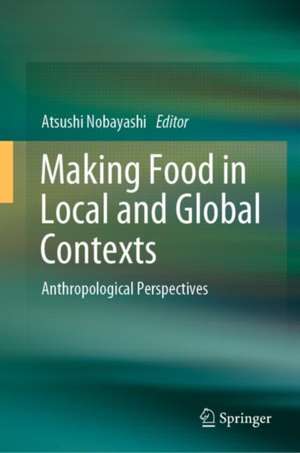Making Food in Local and Global Contexts: Anthropological Perspectives
Editat de Atsushi Nobayashien Limba Engleză Hardback – 22 iun 2022
| Toate formatele și edițiile | Preț | Express |
|---|---|---|
| Paperback (1) | 1105.50 lei 6-8 săpt. | |
| Springer Nature Singapore – 23 iun 2023 | 1105.50 lei 6-8 săpt. | |
| Hardback (1) | 940.99 lei 17-23 zile | +80.11 lei 6-10 zile |
| Springer Nature Singapore – 22 iun 2022 | 940.99 lei 17-23 zile | +80.11 lei 6-10 zile |
Preț: 940.99 lei
Preț vechi: 1238.14 lei
-24% Nou
Puncte Express: 1411
Preț estimativ în valută:
180.08€ • 186.03$ • 149.87£
180.08€ • 186.03$ • 149.87£
Carte disponibilă
Livrare economică 01-07 martie
Livrare express 18-22 februarie pentru 90.10 lei
Preluare comenzi: 021 569.72.76
Specificații
ISBN-13: 9789811910470
ISBN-10: 9811910472
Pagini: 211
Ilustrații: X, 211 p. 45 illus., 35 illus. in color.
Dimensiuni: 155 x 235 mm
Greutate: 0.51 kg
Ediția:1st ed. 2022
Editura: Springer Nature Singapore
Colecția Springer
Locul publicării:Singapore, Singapore
ISBN-10: 9811910472
Pagini: 211
Ilustrații: X, 211 p. 45 illus., 35 illus. in color.
Dimensiuni: 155 x 235 mm
Greutate: 0.51 kg
Ediția:1st ed. 2022
Editura: Springer Nature Singapore
Colecția Springer
Locul publicării:Singapore, Singapore
Cuprins
Table of Contents
Preface and Acknowledgment
Introduction.
Atsushi Nobayashi
Part 1. Ecology and Food Chapter 1.
Gastronomical goods as a biocultural value of wood pastures in Eastern Europe.
Anna Varga, Nikolett Darányi, Krisztina Molnár, Zsolt Molnár and Noémi Ujhá-zy.
Chapter 2.
Merroir in the Making: Provenance Fetishism and the Social Construction of Taste in the Japanese Seafood System.
Shingo Hamada.
Chapter 3.
The Socio-Cultural Reception of MSG (Monosodium Glutamate) in Thailand.
Yoshimi Osawa.
Part 2. Social context of Food
Chapter 4.
Sharing food and conviviality in the Mediterranean Diet. Some ethnographic examples
Elisabetta Moro and Rossella Galletti.
Chapter 5.
Rethinking foodscapes: Does it matter how food reaches my plate?
Cristina Grasseni
Chapter 6.
Rethinking family commensality: Through Japanese cases and Italian ones Taeko Udagawa
Part 3. Ethnicity in Foodscape
Chapter 7.
The “Making” of Hakka Cuisine: A Case Study for the Formation of Ethnic Food and its Foodscapes in Southeast China.
Hironao Kawai.
Chapter 8.
Tubawan and the Play of Authorial Slippage: The Sani Yi people’s practice of hospitality business and the making of indigenous foodscape.
Rongling Ge.
Chapter 9.
Translocal Foodscapes: Gastronomic Creativity in Mérida, Mexico, and Seville, Spain.
Steffan Igor Ayora Diaz.
Part 4. Food and the nation
Chapter 10. The Tea Industry in Modern China and Public Demand for Tea
Jianping Guan
Chapter 11.
On the Formation of Chinese National Cuisine: Historical and Anthropological Perspectives
Haruhiko Nishizawa
Preface and Acknowledgment
Introduction.
Atsushi Nobayashi
Part 1. Ecology and Food Chapter 1.
Gastronomical goods as a biocultural value of wood pastures in Eastern Europe.
Anna Varga, Nikolett Darányi, Krisztina Molnár, Zsolt Molnár and Noémi Ujhá-zy.
Chapter 2.
Merroir in the Making: Provenance Fetishism and the Social Construction of Taste in the Japanese Seafood System.
Shingo Hamada.
Chapter 3.
The Socio-Cultural Reception of MSG (Monosodium Glutamate) in Thailand.
Yoshimi Osawa.
Part 2. Social context of Food
Chapter 4.
Sharing food and conviviality in the Mediterranean Diet. Some ethnographic examples
Elisabetta Moro and Rossella Galletti.
Chapter 5.
Rethinking foodscapes: Does it matter how food reaches my plate?
Cristina Grasseni
Chapter 6.
Rethinking family commensality: Through Japanese cases and Italian ones Taeko Udagawa
Part 3. Ethnicity in Foodscape
Chapter 7.
The “Making” of Hakka Cuisine: A Case Study for the Formation of Ethnic Food and its Foodscapes in Southeast China.
Hironao Kawai.
Chapter 8.
Tubawan and the Play of Authorial Slippage: The Sani Yi people’s practice of hospitality business and the making of indigenous foodscape.
Rongling Ge.
Chapter 9.
Translocal Foodscapes: Gastronomic Creativity in Mérida, Mexico, and Seville, Spain.
Steffan Igor Ayora Diaz.
Part 4. Food and the nation
Chapter 10. The Tea Industry in Modern China and Public Demand for Tea
Jianping Guan
Chapter 11.
On the Formation of Chinese National Cuisine: Historical and Anthropological Perspectives
Haruhiko Nishizawa
Notă biografică
Atsushi Nobayashi is a professor in the National Museum of Ethnology, Japan, and the Graduate University for Advanced Studies, Japan. His research focuses on the ethnicity of Formosan indigenous people, the history of human–animal relationships, and food civilization. His recent research has focused on tool making and cooking as a characteristic of Homo sapiens. He has also been involved in exhibitions at museums in Japan and abroad. He has published several books in the field of the Formosan study and culture of food.
Caracteristici
Considers food at different ecological scales in local and global contexts
Compares food making between and within Europe and Asia
Takes anthropological approaches to holistic food-related challenges
Compares food making between and within Europe and Asia
Takes anthropological approaches to holistic food-related challenges
